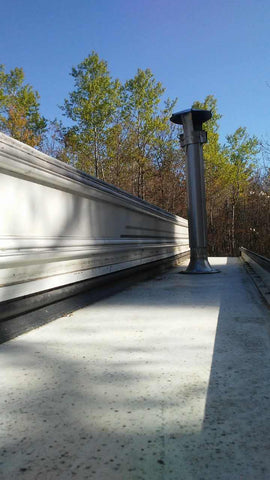To use the stove properly and efficiently, you must first understand some core principals. These will make it much easier to operate the stove and to troubleshoot any problems that may occur.

Is a Proper Draft being created inside your Flue Pipe?
The primary concept to understand is the draft. Draft gets created in the pipe. This is caused by the upward motion of hot air, pulling the air behind it into the stove allowing it to function. Without the pipe, the stove would just be a metal box with fire inside it. The use of a double wall flue pipe is essential to create a proper draft. The double wall construction prevents the gases from cooling too much, which will maintain a proper draft. Otherwise, a single wall pipe will cool the gases and equalize the temperatures, which will reduce the upward pull of the hot air. Also, having an extensive amount of pipe on the outside can slow the draft. The colder outside temperature will cool the pipe quicker than the pipe inside. So if you have more than 2 feet of pipe, it is a good idea to insulate the pipe, which will reduce the cooling of the exterior portion. So the idea is to have a hot flue pipe, which will ensure that the draft is properly created. If these guidelines are followed and you are still experiencing issues, it could be something other than the pipe.
What is the status of the air? Is it being replaced?
When the stove is in use, it is expelling air from inside the space that it's heating. This air needs to be replaced, typically by opening a window slightly. Side note ** We have a wall mount with a fresh air intake that will allow for this replacement to come in without opening a window ** If there is no way for air to come in, the air going into the stove and up the pipe will be slowed down, which will greatly reduce the performance of the stove and be unsafe for the occupants of the space. So, you need to have an intake of air at all times when the stove is in use. Otherwise, the stove will not be efficient. A good example to explain this concept is pouring liquid out of a container. When you pour liquid out of a container, air will be going back in. The air going in is replacing the volume lost by the liquid leaving the container. As a result, it will “glug”. But, if you puncture a hole in the container, the pouring of the liquid will not “glug”. It will pour smoothly because the air is being replaced in the container at the exact same time as the liquid leaving the container. The idea with wood stoves and air replacement is the same.
How to handle Backdraft?
Backdraft is another thing to take note of. If smoke comes back into the space, this can be caused by a few things. One could be that the pipe is too clogged and it is not allowing for proper evacuation of the gasses. In that case, the pipe needs to be cleaned. The other could be the location of the air intake. The air intake should be upwind so that the air gets blown into the space and goes into the stove and out the pipe instead of down the pipe, into the space and out the window. Another cause could be that the cap is not above the highest point of the roof. If it does not surpass the peak by one foot, the cap may be in an area where the air does not pass across it. This would prevent the exit of the fumes, which will return back into the space. The last thing could be a fan that is sucking air out. This would also pull the smoke out from the stove and pipe and pull it into the space.
Is your stove properly lit?
How the stove is lit is also important for efficient use of the stove. If the stove is improperly started, it will take a while for the stove to get going. We touched upon this is past blog posts; check them out to see exactly how to start the stove which will also improve functionality.

What type of wood are you using?
The type of wood used is also very important. We touched upon this in a previous blog as well. Using proper wood will greatly change how the stove works. If the wood is too “green” and not dry enough, it will not work like it should. Well-seasoned hard woods burn hotter and longer than soft woods, which allows for a better draft. It also allows for a cleaner burn since hard woods have much less resin, sap and oils that can clog the pipe quicker compared to other woods.
With a mini wood stove, the smallest detail can impact the whole system. So the more you know about how it works, the better you can diagnose issues and solve them. If you are ever unable to resolve an issue yourself, you can always ask us and we will be glad to help.

